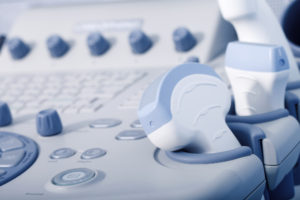8 Signs You Need Ultrasound Probe Repair Services
 Damaged ultrasound probes can lead to misdiagnosis as well as danger for techs and patients. Some issues can even cause more costly damage if not addressed promptly.
Damaged ultrasound probes can lead to misdiagnosis as well as danger for techs and patients. Some issues can even cause more costly damage if not addressed promptly.
Buying a new machine is expensive. But fortunately, most damage can be repaired by a probe repair expert.
Let’s explore 8 common probe issues, what causes them, how to prevent them and when you need probe repair.
1. Lines on the Screen
Black lines in your image aren’t normal. And you don’t have to put up with them. These lines, also called “Dropout, happen when one of the piezoelectric crystals stopped sending and receiving signals.
Some dropouts are seemingly harmless. They just hang out on the side of the screen. But others are larger and can impact a diagnosis.
“Weak” elements are the faint little lines that don’t obscure much. These are the first signs that your elements are going out and need to be replaced.
We call them “Dead” elements when the line is thick and pronounced. If you’ve gotten to this point, then you’re already running the risk of missing something important.
Around 12 million patients get a misdiagnosis each year. A properly displaying machine helps ensure, this isn’t another one.
2. Damage to the Cable Sheath
Do you see little cuts or tears in the sheath on your cables? This may seem like no big deal. We don’t think of the cord as a critical component of the delicate mechanisms in an ultrasound machine.
But think again. Damages cable sheaths create a significant risk of electrocution. Staff or a patient could be hurt.
This kind of damage most commonly occurs when the cord is carelessly run over by bed wheels or chair legs. The rubber may seem durable. But it can only take so much so take care protecting your cables.
And if they are damaged, you need probe repair services to fix the damage.
3. Broken Locking
Portable ultrasounds get this a lot. Some manufacturers are better than others at creating durable locking mechanisms.
Connectors are made to take a beating but quick, off-center and repetitive tugs and insertions can cause them to wear out over time. When the connector is damaged it may not fit securely.
It might even fallout.
This can make it harder for your techs to use the device, causing time waste and unhappy patients. This happens a lot with portable machines. It’s completely fixable.
We see this a lot in the laptop-type connectors.
Train staff on how to properly and carefully remove and insert connectors to extend their usage.
4. Shadows & Light
These are also called “dropout”. But they manifest a little differently. Patches of lighter areas or darker areas may appear on the screen.
It’s normally caused when the lens start to detach in spots. Over time, it will get worse.
Sometimes it’s caused by:
- Cable damage
- Acoustic array damage
- Electronic failure
5. Cracked Membrane
The membrane is soft but as durable as possible. Despite this fact, it can still get damaged from prolonged and frequent use.
This is a very simple fix that can really improve your images. Don’t delay if it’s worn, cracked or developing holes.
6. Probe Leakage
The 3D/4D probes have very soft shells. It’s not always easy to know what’s causing it. But when it happens, you’ll see a wave when you turn it all the way up whiles facing down, then turn it up quickly.
The oil inside the casing is shifting, causing the effect. The back and forth motion of the traducer just makes matters worse.
7. Cracked Strain Relief
A cracked strain relief may occur where the probe attaches to the cable. But you may also see it at the traducer connector.
This isn’t a hard one to spot. The separation will be very visible. When it occurs, don’t wait to get it repaired. Once the sensitive insides are exposed, they can be easily damaged, leading to more costly repairs.
8. Lens Failure
Over time, hairline slices and more visible ones can impact the lens. Not only can this affect image quality, you are exposing patients to viruses and bacteria that can get trapped in these little crevices.
An estimated 1.7 million people contract infections in a healthcare setting each year. Getting the machine fixed helps you be part of the solution.
On top of this, it creates a risk of electrocution.
If the lens is starting to show wear, get it replaced sooner rather than later to avoid cross-contamination.
Diagnosis & Recommendations
When you call for probe repair, your equipment will need to get a diagnosis — not unlike your patients. As we’ve discussed some issues may have multiple causes. And some are easier to spot with the naked eye than others.
If you’re experiencing any of the above symptoms, an expert diagnosis is in order. Once your machine is diagnosed, an expert probe repair company like us will make recommendations and estimates for the repairs.
Repair or Replace?
What’s the Verdict?
In most cases, an ultrasound probe can be repaired. Many repairs are inexpensive and can prevent more costly damage.
If your probe is showing the above symptoms, get it checked out sooner rather than later.
Probe Rentals Keep Your Office Running
Many small practices can’t be without their machine. They rely on it on a daily basis to meet patient needs.
Because of this, they may delay getting their ultrasound machine checked out. But there’s no reason to delay probe repair.
But you should know that low-cost rentals are often available so that your practice can continue to schedule appointments that require the device.
Probe Repair Made Easy
Is your ultrasound experiencing any of the above symptoms? Whether it’s shadows, lines or cracks, it’s time to get it checked out.
If you’re having issues with your ultrasound probe, the first step is to get it diagnosed. We can evaluate the symptoms — both obvious and not so obvious. Then you’ll get a free quote.
We make getting your machine repaired quick and easy. And we do it right. Contact us today to get a quote.
